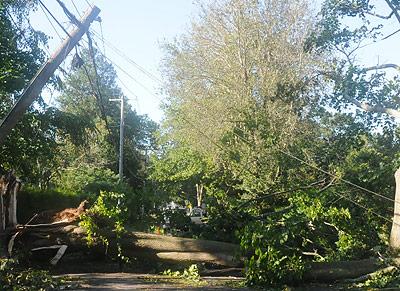The Long Island Power Struggle

Tropical Storm Irene may have been more bark than bite for most East Enders, but the Long Island Power Authority’s struggle to get power restored to thousands of customers caused a storm of outrage that has lasted more than a week.
“On a grading scale of pass-fail their grade is C minus, and even then I am being gracious,” East Hampton Village Mayor Paul F. Rickenbach Jr. said in a statement issued on Friday. In it, he also praised village personnel and volunteers for their emergency response.
“It is one thing for a LIPA customer not to be able to leave the appropriate message of an outage, but when local government, i.e., your village, has to undergo phone transferal from one person to another seeking answers to substantive questions regarding power restoration, something is totally out of whack,” Mr. Rickenbach said.
The mayor’s statement echoed similarly critical ones earlier last week from State Assemblyman Fred W. Thiele Jr. and State Senator Kenneth P. LaValle.
It was clear to anyone who drove through East Hampton last week that not only were LIPA workers and contractors in the area, but so were other electrical teams from as far away as Missouri. However, as late as Tuesday afternoon, pockets of houses, most notably in Amagansett and Springs, remained in the dark.
Roger Grunewald is a resident of Old Stone Highway in Springs whose house was one of five or six in a small area that was without power for a week.
“It came back on about 11 a.m. on Sunday,” he said. Mr. Grunewald had called the LIPA hotline “pretty much from Tuesday on, getting that message that said my outage had been recorded.”
On Sunday morning, he received an automated call back from the company, assuring him that power would be restored that day. “My wife and I went to the beach,” he said. “When we got back, it was on.”
According to Vanessa Baird-Streeter, a spokeswoman for LIPA, “about 96 customers lingered on into Monday,” although, she added, the moderate wind gusts and rains that assailed the area on Monday night into Tuesday morning actually helped, not hindered.
“In some cases, trees and branches may have been leaning on wires, and the storm that happened Tuesday may have removed those branches and alleviated the problems,” she said.
During the tropical storm surge on Aug. 28 alone, LIPA fielded over 875,000 calls, she said. “There was mass devastation across Long Island,” Ms. Baird-Streeter said, which resulted in a “lack of communication.”
She explained that, to expedite services, LIPA delegated local control to a series of mini-substations, “which were not designed to be control stations.” There was a breakdown in communications, not between the customers and the automated messages, which entered outage information directly into the system, but between these local control stations and command central.
“Any time we go through a significant weather event, there are lessons learned,” she said.
In East Hampton, where many houses have private wells, running water — and flushing toilets — was an issue after a few days, as was food spoilage.
“By Wednesday, we had to throw out all the food in the refrigerator,” said William Sherman of Abram’s Landing Road in Amagansett. “Steak, chicken, frozen vegetables, cheese which had melted, all in the garbage,” he said. The Shermans’ power was restored on Saturday afternoon.
“Some of my neighbors had power, people across the street,” he continued. “We saw crews on Tuesday [Aug. 30] on our road, and we asked them when the power would come back on. They said, ‘We’re doing primaries now, you’re a secondary.’ ”
Those terms, primaries and secondaries, may have been unknown to those not in the power business before Irene hit the South Fork, but now they’re understood. Primaries are lines that serve a large number of customers. Secondaries are the offshoots that serve a smaller number of people.
“Over all, I understand that their first objective was primaries. I even agree with it,” Mr. Sherman said. “But they just had to run one wire for us to get power. It would have taken 15 minutes. They were working 20 yards from my house. They weren’t rude about it, they just said, ‘We don’t have that assignment, we can’t do it.’ ”
“One guy was local, a Bridgehampton worker. He was amazed that the contracted workers wouldn’t do it. He said he would have.”
Mr. Grunewald laughed the LIPA situation off. “I’ve been here 40 years,” he said. “In the ’70s and ’80s, if you sneezed at the dinner table, the lights went out. But after [Hurricane] Bob, they started a pretty vigorous campaign for tree trimming and all that. It’s been pretty good since then.”
